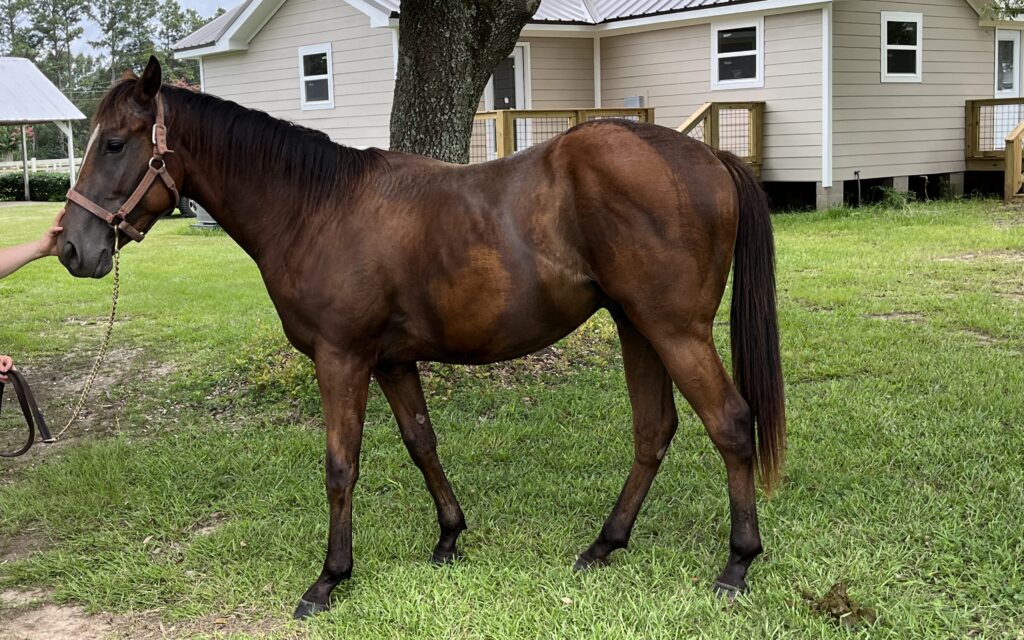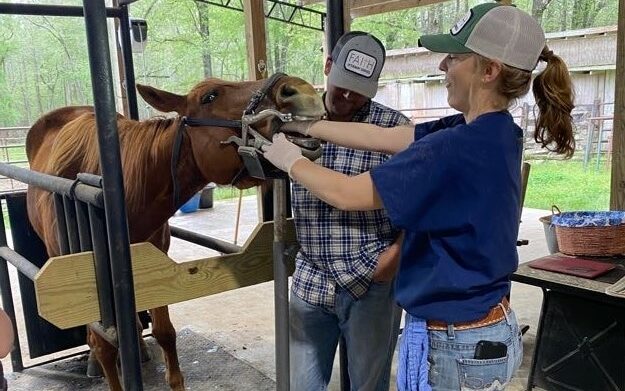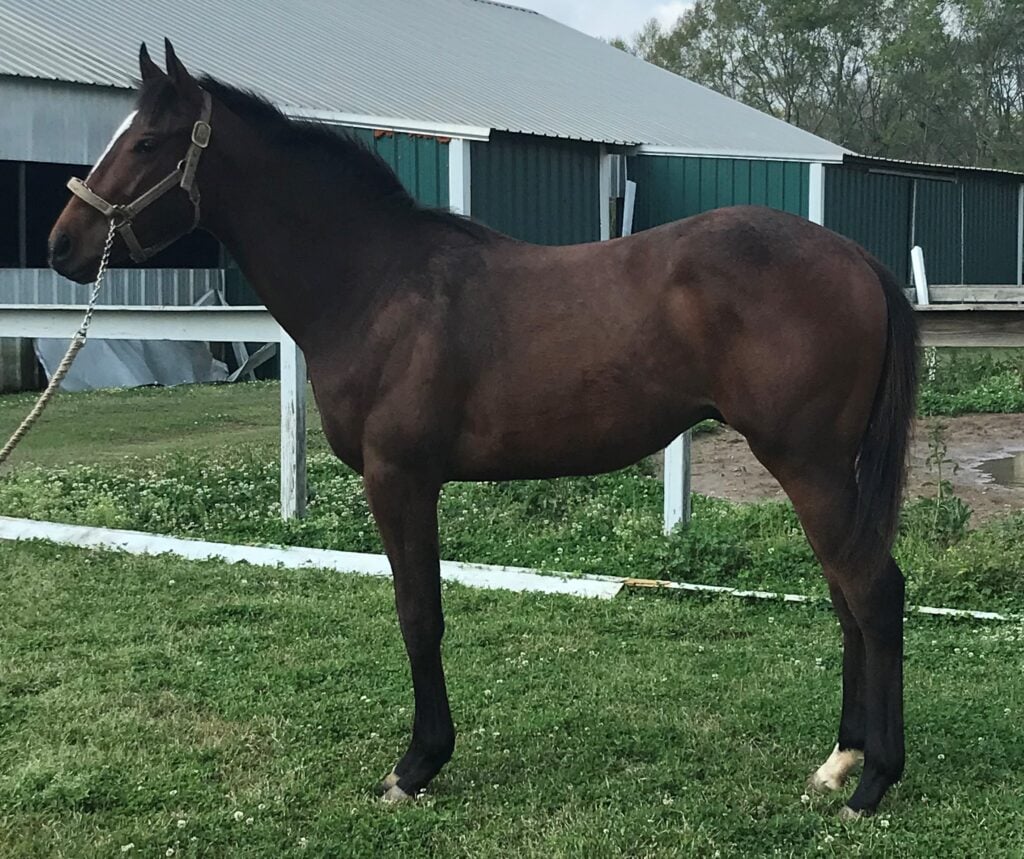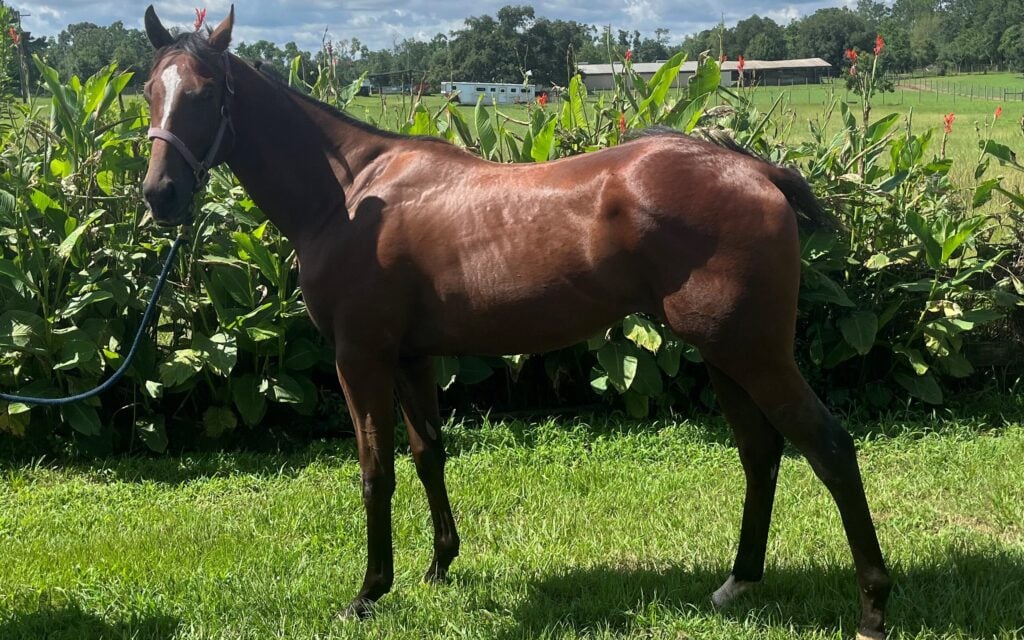What to Feed and Older Horse to Help Gain Weight
Any links on this page that lead to products on Amazon are affiliate links and I earn a commission if you make a purchase. Thanks in advance – I really appreciate it!
I was so relieved our horse made it through his illness, but he lost a lot of weight during his sickness. I was coming up with a plan for getting him back into shape when my grandson asked me about the timeline of this process and what he could do in order to give an additional boost to recovery!
In general, healthy horses gain the weight they lost in four months, and you should see noticeable signs of weight gain within 90 days. However, some may take considerably longer to restore their lost weight, depending on the length of their sickness and age.
Many horse owners believe packing on calories is the way to increase a horse's weight. But that isn't always the case. Horse weight loss is a sensitive issue and must be addressed with a carefully thought-out plan.
The best way to get a horse to gain weight.
Above is a picture of a two-year-old Thoroughbred colt we bought along with four others. All of them were underweight. The first picture was taken on February 2, and the second picture was taken about eight weeks later in April. (I have more before and after photos below).
It's hard to believe it's the same horse, but it is. The first step we took was to have the horse vet checked and wormed; then, we designed a diet and an exercise plan.
So before you concern yourself with its diet, ensure your horse is healthy. If you notice your horse losing weight after being in recovery mode for two weeks, bring him back to the veterinarian right away.
Once you've confirmed your horse isn't sick, start feeding a nutritious diet. Without good nutrition, a horse can't recover from an illness and gain weight.
Ensure your horse gets an adequate amount of high-quality protein. Horses need more protein when they're sick or recovering – this helps them build their muscles back up again so that they'll be strong enough to keep fighting off the disease.
Horse owners know that it's vital for a horse to put on weight. But feeding the wrong kind of food or too much and they won't progress or can get sicker than before. However, there are some steps you can take to ensure your horse is on the right track.
Two common problems that prevent horses from a quick recovery are their teeth and worms. Horses' teeth need to be checked, and they should be on a deworming plan. For horses to get the most out of their food, they need to chew correctly, so have their teeth checked and corrected if needed.
Horses are susceptible to worms that prevent them from absorbing nutrients from their food, leading to weight loss or malnutrition. So, if your horse isn't on a worming program, start one now. Now let's move on to the feeding program.
Hay is an essential source of fiber and nutrition, so it must always be available. Free access to fresh, clean water is also vital. Ensure your horse eats at least 1.5 percent of its weight in quality hay. Hay should provide 1000 kilocalories per pound.
The next few ingredients you should add to your horse's diet are alfalfa and beet pulp. These two high-calorie foods help prevent malnutrition, which can be common in underweight horses.
Farnam Weight Builder Equine Weight Supplement 7.5 Pound, 30 Day Supply
- Adds calories without the risk of digestive upset
- 50% fat provides more calories per serving* to help horses reach their ideal weight *Compared to the original formula
- No sugar added for horses with dietary restrictions
- Promotes healthy skin and a glossy coat
- Delivers a calming energy for performance
- Rich in omega-3 fatty acids from flaxseed meal and heat stabilized rice bran
- Ideal for performance horses, mature horses, underweight horses & seniors
- Added calcium helps maintain the calcium:phosphorous ratio
- Part of the Horse Care Loyalty Rewards Program
Prices pulled from the Amazon Product Advertising API on:
Product prices and availability are accurate as of the date/time indicated and are subject to change. Any price and availability information displayed on [relevant Amazon Site(s), as applicable] at the time of purchase will apply to the purchase of this product.
For horses having difficulty putting on weight, I recommend adding commercial feeds such as Weight Builder or Triple Crown Complete; these commercial feed supplements provide nutrient-dense calories without a lot of sugar!
A thin horse might be at risk for many health problems, so if your horse isn't bouncing back, it's essential to work with an equine veterinarian and nutritionist to adjust its feeding plan.
When feeding horses that lost significant weight, increase calories slowly to avoid upsetting their digestive tract or causing colic due to sudden diet changes. And it's essential to know the correct weight for your horse.
It would be best to use a formal method to estimate your horses' fitness level and weight because it's difficult to eyeball a change in their weight. You can calculate the animal's weight with a tape measure and the Carroll & Huntington formula: Heart girth (cm) x Heart girth (cm) x Length (cm) divided by 11877 = Weight (kg).
It's also a good practice to evaluate your horse using the Henneke Body Condition Scoring method. The Henneke BCS requires you to assess different regions of the horse's body and score it based on the fat content.
While trying to put weight on a skinny horse, this method is helpful because you go back to the same regions and re-evaluate the horse's fat content in specific areas.
I recently bought some poor-looking two-year-old horses, each was underweight, and two had rain rot. The first thing I did was worm each of them, checked and fixed their teeth, and started feeding them three times a day. Here are the basic steps you should take to put weight on your horses.
1. Check your horses' teeth
When horses chew on food, they grind their teeth, keeping them from growing too sharp and long. But, they often don't do a good job, so the teeth eventually turn sharp. When this occurs, the horse drops feed because it can't chew properly, and the teeth can cut the inside of the horse's mouth.
These problems are often fixed by floating your horses' teeth. I have our horse's teeth floated at least once a year and suggest you do the same.
A horse with bad teeth may not chew its food effectively, sometimes hay, and feed form balls in its mouth, which they spit out. Of course, when this occurs, horses aren't ingesting the hay and miss out on its nutritional value and won't put on weight. Horses also pass unprocessed food through their digestive system.
There are many reasons why your horse's grain is passing right through them. If you see unprocessed grains or oats in their manure, it could be because they need to have the teeth cared for by a farrier or veterinarian.
Horses with malformed teeth cannot chew their food, and this will cause problems with digestion. Most grains have a husk that needs to be broken for their nutrients to be absorbed. Failure to absorb nutrients during digestion can also arise if an animal has ulcers or intestinal parasites.
A horse's dental health can be a complex subject to keep track of. If you notice your horse dropping feed while chewing, it is a common sign your horse has teeth problems that need attention. Other indicators include nasal discharge and foul-smelling breath with facial swellings.
2. De-worm your horse
Internal parasites consume vital nutrients from the food animals eat, often resulting in a horse's weight loss. Because of this, it is essential to have your horse on a deworming program. Be sure to alternate the type of wormer medication you use because parasites develop resistance to dewormers over time.
Routinely checking their stool for larvae and adult worms is critical to ensure your horse is worm-free and the worming plan for your horse is effective. Now that we cleared our horse, let's move on to feeding for weight gain.
3. Give your horse free access to hay and clean water
We must start with the basic needs of horses, and that is quality hay and clean water. An average horse in good shape, not underweight, should eat roughly 1.5 percent of its body weight in forage.
If you were restricting your horse's hay intake, slowly start increasing it until it eats 2.5 percent of its body weight, and then start giving it unrestricted access to eat all the grass hay it wants, not alfalfa. Alfalfa is an excellent source of healthy calories but doesn't provide free access to it, and I will go into more detail on this subject later.
Water is vital to animals' health, and horses need to drink roughly one gallon per hundred pounds of weight. To encourage your horse to drink and avoid dehydration, provide fresh, clean water between 45 and 65 F.

4. Use alfalfa hay to put weight on horses
When a horse owner is trying to help their thin horse gain weight, they should look no further than alfalfa hay (legume). Alfalfa contains more calories and protein than traditional grass hays, making it an excellent choice for an underweight horse.
But alfalfa is best fed mixed with grass hay and beet pulp because of its high protein and calcium levels. Horses that are not active run a risk of putting on too much weight too fast. If your horse is underweight and not fit for strenuous work, you don't want to feed it too much alfalfa.
Alfalfa pellets and cubes are also great alternatives if you don't have much storage space for hay bales and provide the same benefits you get from Alfalfa hay.
5. Beet pulp to put weight on horses
Beet pulp is an excellent choice of calories for underweight horses, and it has the added benefit of providing fiber for hindgut health. The microbes in the horse's hindgut can quickly ferment beet pulp, making it an excellent energy food source.
The downside of beet pulp is that it's low in protein. I found a mixture of beet pulp, alfalfa, and grass hay is the best mixture to put weight on thin horses.
I recommend soaking beet pulp before feeding it to your horse to make it more palatable.
6. Commercial feeds to use to put weight on horses
There are many commercial feed supplements that you can use to help your horse gain weight. The two I'm familiar with are Weight Builder and Triple Crown Complete. Weight Builder is manufactured by Farnman, a trusted name in Equine supplements.
Triple Crown Complete is a high-fiber beet pulp-based feed that includes alfalfa, oats, and flaxseed. It provides 12% protein, 12% fat, and all the calories, vitamins, and minerals of a grain-based feed without the potentially harmful soluble carbohydrates.
7. Feeding Grain
In addition to allowing free access to pasture or hay, you need to feed your underweight horse grain. Grains typically contain higher concentrations of protein and fat to aid in gaining weight.
Prices pulled from the Amazon Product Advertising API on:
Product prices and availability are accurate as of the date/time indicated and are subject to change. Any price and availability information displayed on [relevant Amazon Site(s), as applicable] at the time of purchase will apply to the purchase of this product.
If you've been feeding grain, switch to a feed made for underweight horses like Hygain Showtorque. Hygain makes a couple of feed products and supplements to safely add to your horses' diet to increase your horses' calorie content.
Their Hygain Showtorque is a high-fat feed concentrate that you could slowly introduce to your horse's diet. I haven't used their product, but the ingredients and fat content look promising, and the company places emphasis on hard keepers.
If your horse is sensitive to change, top your current grain, and add a high-fat supplement like rice bran, flaxseed, vegetable oil, or dried granular fats. If your horse refuses to eat, it may have a medical condition so contact a vet right away.
Prices pulled from the Amazon Product Advertising API on:
Product prices and availability are accurate as of the date/time indicated and are subject to change. Any price and availability information displayed on [relevant Amazon Site(s), as applicable] at the time of purchase will apply to the purchase of this product.

How can I get my horse to gain weight and muscle?
A proper diet that includes amino acids, the building blocks of proteins, and exercise is needed to develop their muscles. Horses can only synthesize 12 of the 22 amino acids responsible for protein production, so they need to get the other ten essential ones from food.
When these amino acids come together, they form protein chains that grow muscle. And while it's possible to build muscle over the short term by feeding high protein diets, for optimal muscle development, your horse needs to consistently take in the correct amount of amino acids over its lifetime.
Muscles are constantly breaking down and building up, so they need to take in food to fortify their muscles continually. Exercise also plays a crucial role in building muscle.
Regular workouts are essential to promote muscle growth. Horse owners must exercise their horses on an ongoing basis for healthy muscle development and maintenance.
Physical activity works hand-in-hand with amino acids–the building blocks of protein structures within cells–for more significant metabolic function as well as physical performance!
What is the best muscle builder for horses?
To add muscle, you need the correct amount of amino acids, so start by evaluating your feeding program. Your horse may be getting everything it needs, and additional protein can't be absorbed and is passed through in your horse's urine.
So don't waste your money, but if your horse needs additional amino acids, there are a few products available such as Science Supplements – The Equine Nutrition Specialists Muscle Builder and Finish Line Muscle Tone. Both of these products are good sources of amino acids needed for your horse's muscle development.

How do you build muscle in a horse's hind end?
One key component to a horse's performance and overall health is strong hindquarters, so strength training after significant weight loss can be crucial. The horse pictured above was one of five two years old we bought that were severely underweight.
To build muscle in these young horses, we devised a regular riding and exercise program without focusing on one particular region of their body. By working on increasing their overall muscling, we noticed their hindquarters develop.
However, for some horses with weak hindquarters, we have concentrated on this region. A couple of things I find helpful are riding hills, backing my horse, and riding over obstacles.
Horses typically gain muscle throughout their bodies, not in one specific region. With proper feeding and regular exercise, your horse should develop its hindquarter muscles.

How do I build my horse's topline?
Horses naturally have a strong topline, so if yours doesn't, try to figure out the cause. Start with a vet check of your horse and also the fit of your saddle fit. It would be best if you cleared up the reason before working on building up the top line.
Once you have addressed the cause, you can implement a couple of exercises to strengthen your horses' topline. The topline is your horse's core, so a strong topline is essential to your horse's overall physical health.
A good topline strengthening exercise is the baited carrot stretch. Horses are captivated by carrots and will stretch their necks to reach a treat. Hold a carrot between their front legs and coax them to get the treat. This exercise stretches out its neck and topline and helps strengthen it.
As I stated above, riding up and down hills is good for strengthening the hindquarter muscles, and it also builds up the horses' topline. Start by riding hills at a slow, steady pace until your horses' fitness level allows you to pick up the pace.
Butt tucks are a fun and engaging way to build up your horse's top-line and hindquarter muscles. To perform this exercise, run your fingers down the muscle creases on both sides of their rump while they're standing still-they'll immediately round out on themselves in response.
Conclusion
If your horse is healthy, it should be back to its correct weight in four months, and you'll notice a marked improvement within 90 days. To put some pounds on the horse quicker, give them lots of grass hay mixed with alfalfa and beet pulp.
Feeding them high-fat commercial grain mixes will also help speed up their growth. Please make sure they always have plenty of clean water available for drinking too!
Below is a YouTube video that explains how to feed your horse to help it gain weight.
FAQ
Does lunging a horse build muscle?
Lunging is effective in building muscle and improves your horse's natural balance. Working your horse in a circle encourages the muscles to develop. But it would be best if you had a proper lunging routine, so your horse gets the most from the exercise and doesn't become unbalanced.
Do oats help horses gain weight?
Oats alone don't help horses gain weight. Horses love oats, but you should feed them in combination with other food sources. Whole oats are difficult for horses to digest and can pass through their digestive system without being absorbed by the body. If you're a horse owner looking to feed your animal oats, make sure that you soak or steam them first so that nutrients are better available for absorption!
ensleyherhatiought51.blogspot.com
Source: https://horseracingsense.com/how-long-to-put-weight-on-your-horse-7-steps/
0 Response to "What to Feed and Older Horse to Help Gain Weight"
Post a Comment